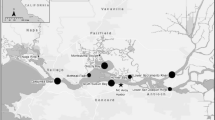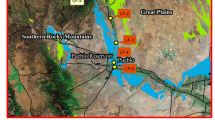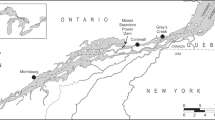Abstract
Sacramento splittail (Pogonichthys macrolepidotus) is a species of special concern in California, due to multiple anthropogenic stressors. To better understand the potential impact of contaminant exposure, adult splittail were captured from the Sacramento-San Joaquin River Delta (California, USA) and analyzed for histopathology and contaminant exposure. Organochlorine contaminants (PCBs, DDTs, dieldrin, chlordanes, and PBDEs) and trace metals (Ag, As, Cd, Co, Cr, Cu, Fe, Mn, Mo, Ni, Pb, Se, Sn, V, and Zn) were detected in the tissues of all fish. In many samples, human health screening values were exceeded for PCBs (83 of 90 samples), DDTs (32 samples), and dieldrin (37 samples). In contrast, thresholds for fish effects were rarely exceeded. Histopathological analysis indicated the presence of macrophage aggregates in gonads, kidneys, and liver and a high incidence of liver abnormalities. In the liver, observed effects were often moderate to severe for glycogen depletion (55 of 95 fish), lipidosis (hepatocellular vacuolation; 51 fish), and cytoplasmic inclusion bodies (33 fish). Correlations between histopathology and tissue contaminant concentrations were weak and inconsistent. Significant correlations were observed between histopathology indicators and reductions in fish size, body condition, lipid content, and liver weight. These results suggest that splittail histopathology varies as a function of health and nutritional status, rather than exposure to legacy organic and metal pollutants.





Similar content being viewed by others
References
Anderson MJ, Cacela D, Beltman D, Teh SJ, Okihiro MS, Hinton DE, Denslow N, Zelikoff JT (2003) Biochemical and toxicopathic biomarkers assessed in smallmouth bass recovered from a polychlorinated biphenyl-contaminated river. Biomarkers 8:371–393
Barron MG, Anderson MJ, Cacela D, Lipton J, Teh SJ, Hinton DE, Zelikoff JT, Dikkeboom AL, Tillitt DE, Holey M, Denslow N (2000) PCBs, liver lesions and biomarker responses in adult walleye (Stizostedium vitreum vitreum) collected from Green Bay, Wisconsin. J Great Lakes Res 26:250–771
Beckvar N, Dillon TM, Read LB (2006) Approaches for linking whole-body fish tissue residues of mercury or DDT to biological effects thresholds. Environ Toxicol Chem 24:2094–2105
Beyer WN, Heinz GH, Redmon-Norwood AW (1996) Environmental contaminants in wildlife: interpreting tissue concentrations. Lewis, Boca Raton, FL, p 494
Brown FR, Winkler J, Visita P, Dhaliwal J, Petreas M (2006) Levels of PBDEs, PCDDs, PCDFs, and coplanar PCBs in edible fish from California coastal waters. Chemosphere 64:276–286
Brown LR (1997) Concentrations of chlorinated organic compounds in biota and bed sediment in streams of the san Joaquin Valley, California. Arch Environ Contam Toxicol 33:357–368
Bunton TE, Frazier JM (1994) Extrahepatic tissue copper concentrations in white perch with hepatic copper storage. J Fish Biol 45:627–640
California Department of Pesticide Regulation (2006) Summary of pesticide use report data 2005. California Department of Pesticide Regulation, Sacramento, p 515 (available at: http://www.cdpr.ca.gov/docs/pur/pur05rep/chmrpt05.pdf)
Central Valley Regional Water Quality Control Board (2003) 2002 CWA Section 303(d) List of Water Quality Limited Segment. Central Valley Regional Water Quality Control Board (available at: http://www.swrcb.ca.gov/tmdl/docs/2002reg5303dlist.pdf)
Connor MS, Davis JA, Leatherbarrow J, Greenfield BK, Gunther A, Hardin D, Mumley T, Oram JJ, Werme C (2007) The slow recovery of San Francisco Bay from the legacy of organochlorine pesticides. Environ Res 105:87–100
Darnerud PO, Eriksen GS, Jóhannesson T, Larsen PB, Viluksela M (2001) Polybrominated diphenyl ethers: occurrence, dietary exposure, and toxicology. Environ Health Persp 109:49–68
Davis JA, May MD, Ichikawa G, Crane D (2000) Contaminant concentrations in fish from the Sacramento-San Joaquin Delta and Lower San Joaquin River 1998. San Francisco Estuary Institute, Oakland, CA, p 52 (available at: http://www.sfei.org/cmr/deltafish/dfc.pdf)
Eder KJ, Leutenegger CM, Wilson BW, Werner I (2004) Molecular and cellular biomarker responses to pesticide exposure in juvenile chinook salmon (Oncorhynchus tshawytscha). Mar Environ Res 58:809–813
Fechhelm RG, Griffiths WB, Wilson WJ, Gallaway BJ, Bryan JD (1995) Intraseasonal and interseasonal changes in the relative condition and proximate body-composition of broad whitefish from the Prudhoe Bay-region of Alaska. T Am Fish Soc 124:508–519
Greenfield BK, Davis JA, Fairey R, Roberts C, Crane D, Ichikawa G, Petreas M (2003) Contaminant concentrations in fish from San Francisco Bay, 2000. San Francisco Estuary Institute, Oakland, CA, p 82 (available at: http://www.sfei.org/rmp/reports/fish_contamination/2000/FishStudy_finalv3.pdf)
Greenfield BK, Davis JA, Fairey R, Roberts C, Crane D, Ichikawa G (2005) Seasonal, interannual, and long-term variation in sport fish contamination, San Francisco Bay. Sci Total Environ 336:25–43
Hendricks JD, Meyers TR, Shelton DW (1984) Histological progression of hepatic neoplasia in rainbow trout (Salmo gairdneri). Natl Cancer Inst Monogr 65:321–336
Hinton DE, Laurén DJ (1990) Liver structural alterations accompanying chronic toxicity in fishes: potential biomarkers of exposure. In: McCarthy JF, Shugart LR (eds) Biomarkers of environmental contamination. Lewis, Boca Raton, FL, pp 17–57
Hinton DE, Baumann PC, Gardner GR, Hawkins WE, Hendricks JD, Murchelano RA, Okihiro MS (1992) Histopathologic biomarkers. In: Hugget RJ, Kimerle RA, Mehrle PM, Bergman HL (eds) Biomarkers, biochemical, physiological, and histologic markers of anthropogenic stress. Lewis, Boca Raton, FL, pp 155–209
Huang X, Hites RA, Foran JA, Hamilton C, Knuth BA, Schwager SJ, Carpenter DO (2006) Consumption advisories for salmon based on risk of cancer and noncancer health effects. Environ Res 101:263–274
Kidd KA, Schindler DW, Hesslein RH, Muir DCG (1998) Effects of trophic position and lipid on organochlorine concentrations in fishes from subarctic lakes in Yukon Territory. Can J Fish Aquat Sci 55:868–881
Loge FJ, Arkoosh MR, Ginn TR, Johnson LL, Collier TK (2005) Impact of environmental stressors on the dynamics of disease transmission. Environ Sci Technol 39:7329–7336
MacCoy DE, Domagalski JL (1999) Trace elements and organic compounds in streambed sediment and aquatic biota from the Sacramento River Basin, California, October and November 1995. Publ 99–4151. USGS, Sacramento, CA, p 37
Matern SA, Moyle PB, Pierce LC (2002) Native and alien fishes in a California estuarine marsh: Twenty-one years of changing assemblages. T Am Fish Soc 131:797–816
McCune B, Grace JB (2002) Analysis of ecological communities. MJM Software Design, Gleneden Beach, OR, p 300 (www.pcord.com)
Meador JP, Collier TK, Stein JE (2002) Use of tissue and sediment-based threshold concentrations of polychlorinated biphenyls (PCBs) to protect juvenile salmonids listed under the US Endangered Species Act. Aquat Conserv Mar Freshw Ecosyst 12:493–516
Moyle PB (2002) Inland fishes of California. University of California Press, Berkeley, p 502
Moyle PB, Baxter RD, Sommer T, Foin TC, Matern SA (2004) Biology and population dynamics of Sacramento splittail (Pogonichthys macrolepidotus) in the San Francisco Estuary: a review. San Francisco Estuary and Watershed Science 2(2):article 3 (available at: http://repositories.cdlib.org/jmie/sfews/vol2/iss2/art3)
Murphy BR, Willis DW (1996) Fisheries techniques. American Fisheries Society, Bethesda, MD, p 732
Myers JT, Hendricks JD (1985) Histopathology. In: Rand GM, Petrocelli SR (eds) Fundamentals of aquatic toxicology. Hemisphere, Washington, DC, pp 283–331
Newman JW, Becker JS, Blondina G, Tjeerdema RS (1998) Quantitation of Aroclors using congener-specific results. Environ Toxicol Chem 17:2159–2167
Peplow D, Edmonds R (2005) The effects of mine waste contamination at multiple levels of biological organization. Ecol Eng 24:101–119
Riley F, Finlayson S (2004) Acute toxicities of herbicides used to control water hyacinth and Brazilian elodea on larval delta smelt and Sacramento splittail. California Department of Fish and Game, Elk Grove, p 14
Robertson JC, Bradley TM (1992) Liver ultrastructure of juvenile Atlantic salmon (Salmo salar). J Morphol 211:41–54
Schmitt CJ, Hinck JE, Blazer VS, Denslow ND, Dethloff GM, Bartish TM, Coyle JJ, Tillitt DE (2005) Environmental contaminants and biomarker responses in fish from the Rio Grande and its US tributaries: spatial and temporal trends. Sci Total Environ 350:161–193
Schrank CS, Cormier SM, Blazer VS (1997) Contaminant exposure, biochemical, and histopathological biomarkers in white suckers from contaminated and reference sites in the Sheboygan River, Wisconsin. J Great Lakes Res 23:119–130
She J, Petreas M, Winkler J, Visita P, McKinney M, Kopec D (2002) PBDEs in the San Francisco Bay Area: measurements in harbor seal blubber and human breast adipose tissue. Chemosphere 46:697–707
Silver E, Kaslow J, Lee D, Lee S, Tan ML, Weis E, Ujihara A (2007) Fish consumption and advisory awareness among low-income women in California’s Sacramento–San Joaquin Delta. Environ Res 104:410–419
Teh SJ, Adams SM, Hinton DE (1997) Histopathologic biomarkers in feral freshwater fish populations exposed to different types of contaminant stress. Aquat Toxicol 37:51–70
Teh SJ, Deng X, Teh F, Hung S (2002) Selenium-induced teratogenicity in Sacramento splittail (Pogonichthys macrolepidotus). Mar Environ Res 54:605–608
Teh SJ, Deng Z, Deng D-F, Teh FC, Hung SSO, Fan TW-M, Liu J, Higashi RM (2004a) Chronic effects of dietary selenium on juvenile Sacramento splittail (Pogonichthys macrolepidotus). Environ Sci Technol 2004:6085–6093
Teh SJ, Zhang GH, Kimball T, Teh FC (2004b) Lethal and sublethal effects of esfenvalerate and diazinon on splittail larvae. Am Fish Soc Symp 39:243–253
Teh SJ, Deng D, Werner I, Teh F, Hung S (2005) Sublethal toxicity of orchard stormwater runoff in Sacramento splittail (Pogonichthys macrolepidotus) larvae. Mar Environ Res 59:203–216
U.S. EPA (2000) Guidance for assessing chemical contaminant data for use in fish advisories. Vol. 1. Fish sampling and analysis. 3rd ed. EPA-823-B-00-007. U.S. Environmental Protection Agency, Washington, DC (available at: http://www.epa.gov/waterscience/fishadvice/volume1/index.html)
U.S. Fish and Wildlife Service (2007) Sacramento Fish & Wildlife Office species account: Sacramento splittail (Pogonichthys macrolepidotus). Available at: http://www.fws.gov/sacramento/es/animal_spp_acct/sac_splittail.htm
van der Oost R, Beyer J, Vermeulen NPE (2003) Fish bioaccumulation and biomarkers in environmental risk assessment: a review. Environ Toxicol Pharm 13:57–149
Acknowledgments
We thank Randall Baxter for assistance with sampling design, coordination, and interpretation; John Negrey, Bryan Frueh, Dylan Service, and Dustin Service for field collection; Jee Liu and Deng Xin for sample preparation, metal analyses, and Se determinations; and Kathleen Regalado, Gary Munoz, Laurie Smith, Matt Hicks, and David Gilman for participation in organics analysis. The constructive comments of two anonymous reviewers improved the manuscript. This study was funded by California Bay-Delta Authority Project 99-N07 and is SFEI contribution no. 540.
Author information
Authors and Affiliations
Corresponding author
Electronic supplementary material
Rights and permissions
About this article
Cite this article
Greenfield, B.K., Teh, S.J., Ross, J.R.M. et al. Contaminant Concentrations and Histopathological Effects in Sacramento Splittail (Pogonichthys macrolepidotus). Arch Environ Contam Toxicol 55, 270–281 (2008). https://doi.org/10.1007/s00244-007-9112-3
Received:
Accepted:
Published:
Issue Date:
DOI: https://doi.org/10.1007/s00244-007-9112-3




